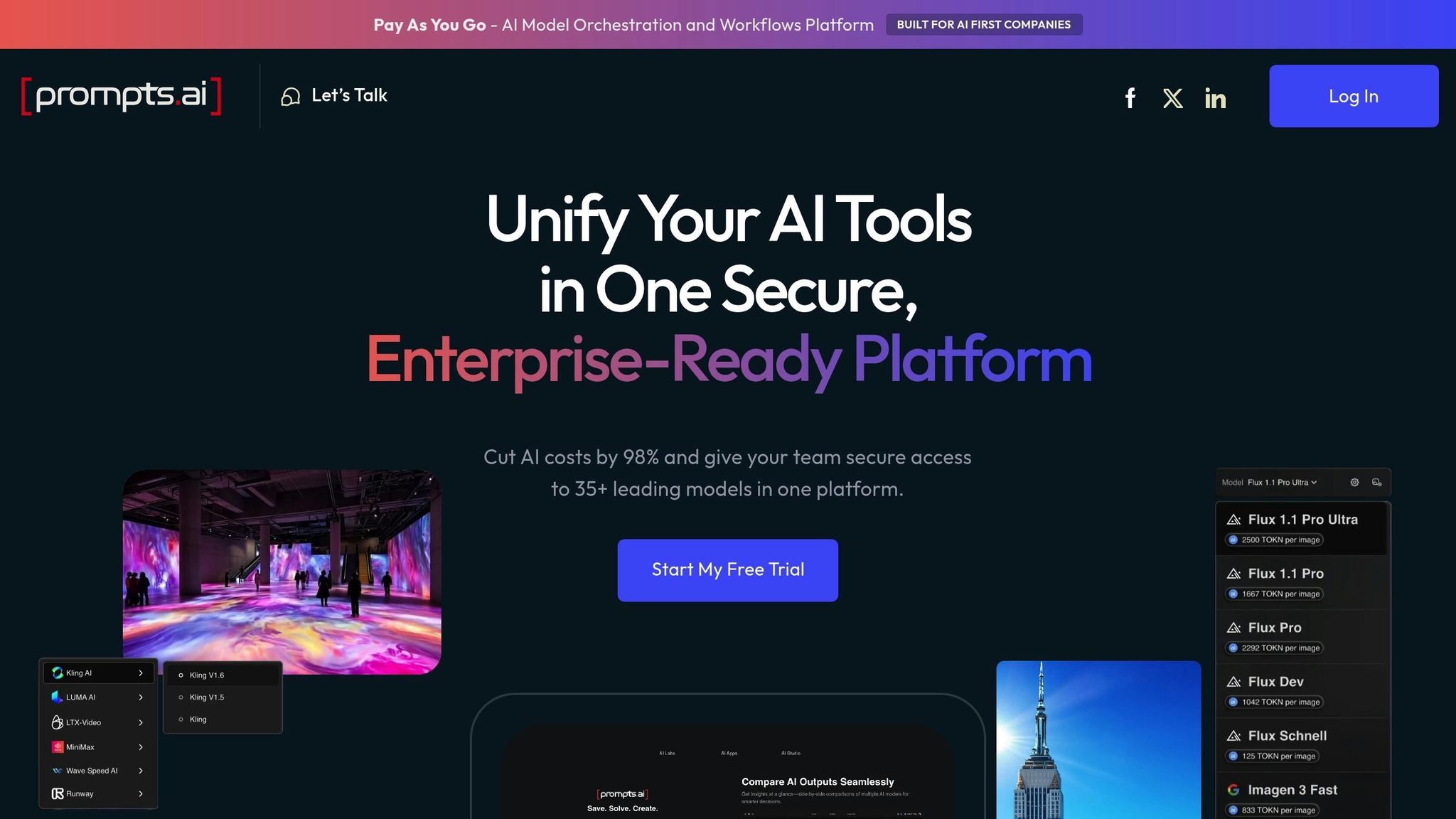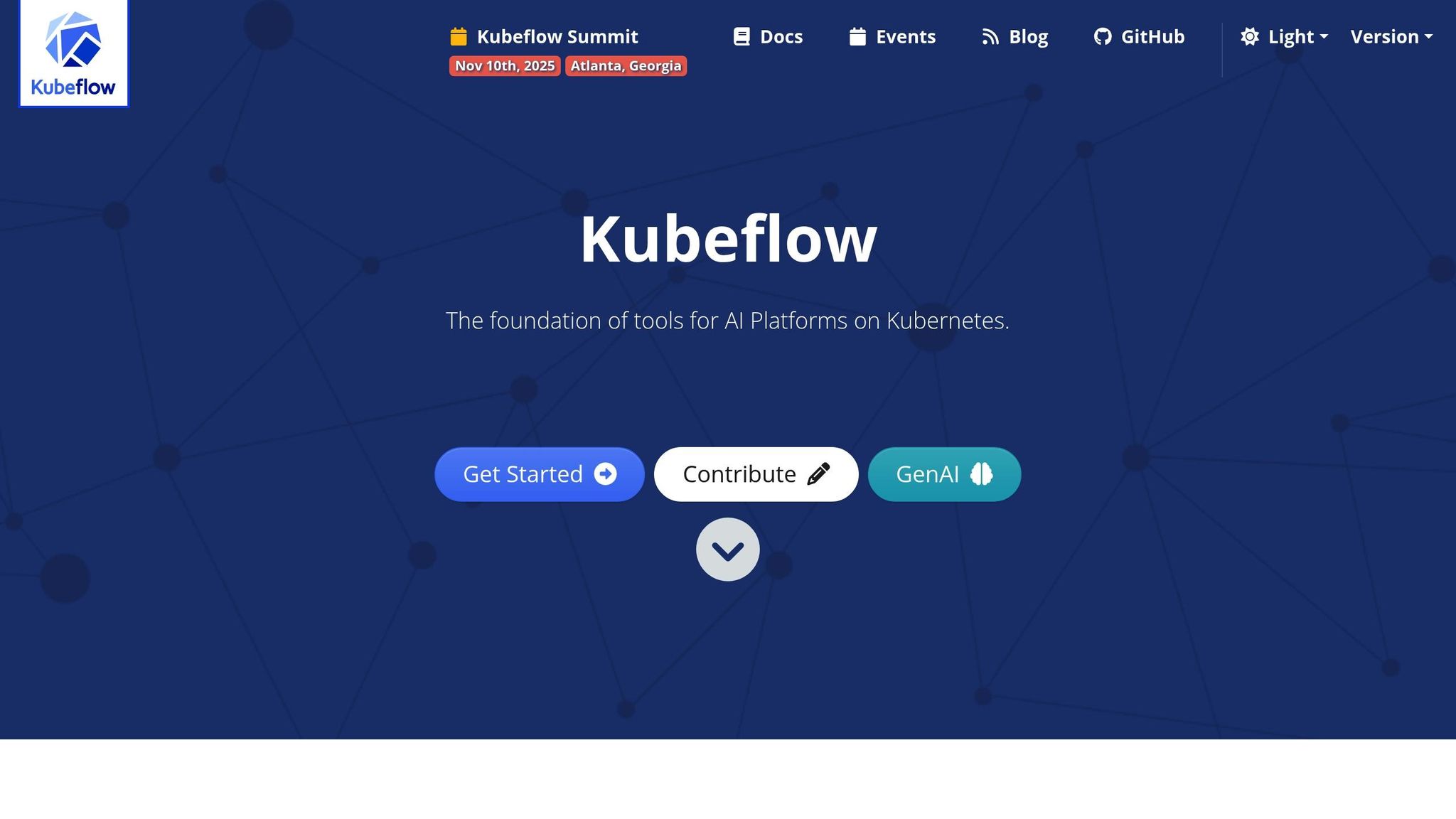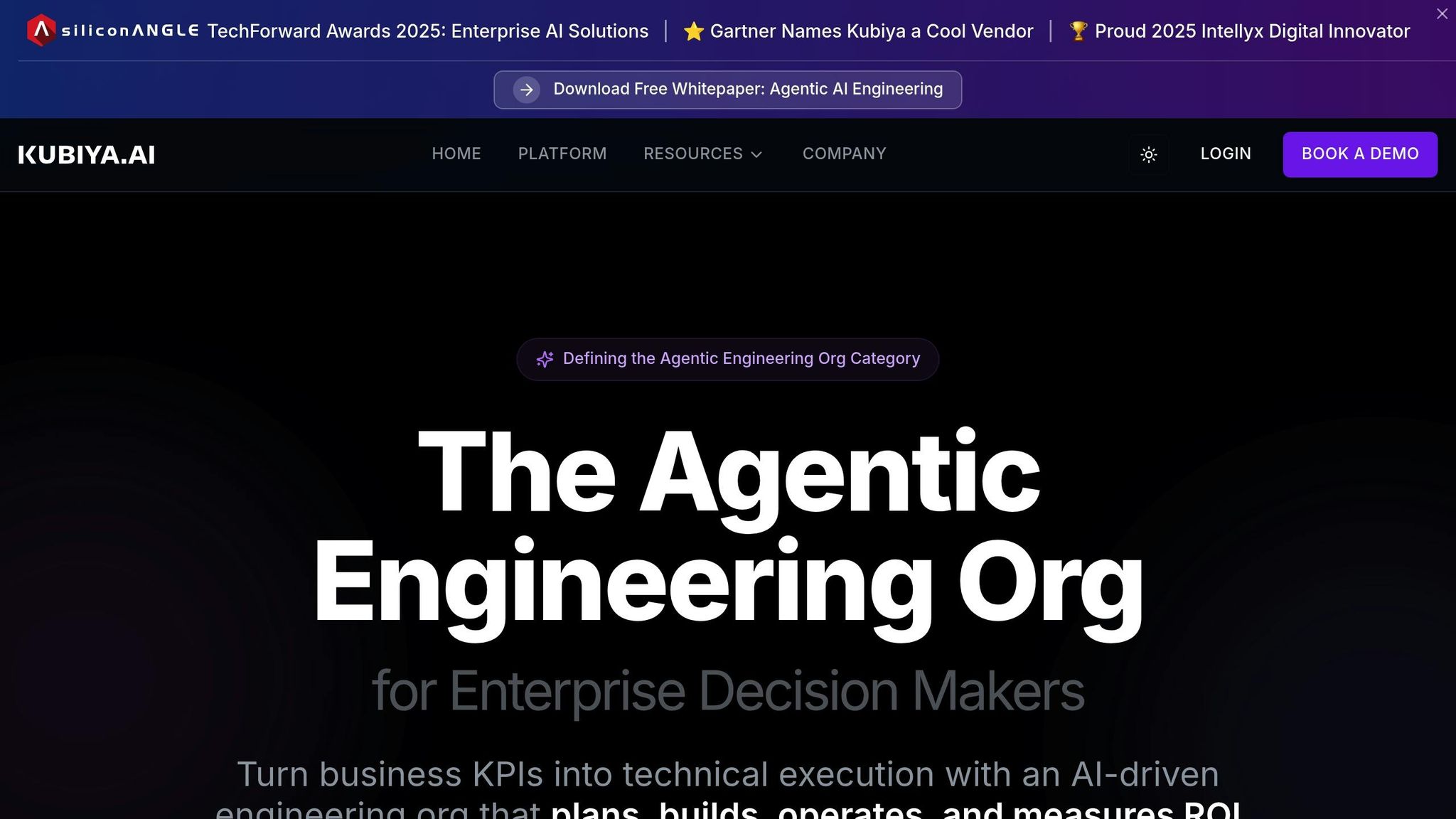
AI model orchestration simplifies managing multiple AI workflows, saving time, reducing costs, and ensuring compliance. This article evaluates Prompts.ai, Kubeflow, and Kubiya AI, highlighting their strengths in integration, automation, and governance. Here's what each offers:
| Feature | Prompts.ai | Kubeflow | Kubiya AI |
|---|---|---|---|
| Model Support | 35+ AI models (e.g., GPT-4) | Framework-agnostic (e.g., TensorFlow, PyTorch) | Infrastructure-focused (e.g., Terraform, Kubernetes) |
| Cost Management | TOKN credits, 98% cost reduction | Free (requires infra/maintenance) | Optimized via automation |
| Governance | SOC 2, HIPAA, GDPR compliance | Kubernetes RBAC, custom setup | Zero Trust, RBAC, audit trails |
| Ease of Use | User-friendly, pre-designed workflows | Technical expertise required | Natural language commands |
Prompts.ai stands out for enterprises needing unified AI management, while Kubeflow suits teams with Kubernetes expertise. Kubiya AI excels in DevOps automation with flexible integrations.

Prompts.ai stands out as an enterprise-level AI orchestration platform, designed to bring all AI model management under one secure, centralized system. It tackles a pressing issue for U.S. businesses: juggling multiple AI tools while keeping costs, security, and efficiency in check.
The platform integrates over 35 leading AI models - including GPT-4, Claude, LLaMA, and Gemini - into a unified, secure interface. This eliminates the hassle of juggling multiple subscriptions and integrations. With its side-by-side comparison tool, teams can evaluate LLMs directly, enabling well-informed, data-backed decisions. This streamlined setup ensures the adaptability needed to meet a variety of organizational demands.
For American businesses, security and compliance are critical, and Prompts.ai delivers with a strong governance framework. The platform adheres to standards like SOC 2 Type II, HIPAA, and GDPR to protect data. It partners with Vanta for continuous monitoring and has initiated its SOC 2 Type II audit process. Through its real-time Trust Center (https://trust.prompts.ai/), organizations gain full transparency into policies, controls, and compliance progress. Every plan includes essential compliance and governance tools at no extra cost, ensuring enterprise-grade security without hidden fees.
Prompts.ai uses a Pay-As-You-Go TOKN credits system that aligns expenses with actual usage, eliminating recurring charges. By consolidating multiple subscriptions into one transparent platform, it claims to cut AI software costs by up to 98%. The integrated FinOps layer tracks every token and directly connects spending to business outcomes, making it easier for organizations to measure ROI and justify their AI investments.
Prompts.ai goes beyond just providing model access. It offers pre-designed prompt workflows, known as "Time Savers", to help teams quickly adapt to AI orchestration. The platform also supports rapid scaling, allowing businesses to add models, users, and teams within minutes. This flexibility ensures it can keep up with the evolving needs of U.S. enterprises, making it a reliable choice for AI orchestration as organizations grow and adapt. These features position Prompts.ai as a standout option for managing enterprise AI workflows effectively.

Kubeflow is an open-source platform designed for orchestrating machine learning (ML) workflows, leveraging Kubernetes to enable scalable deployment and management of AI models. It’s particularly suited for organizations already familiar with Kubernetes, offering flexibility in orchestration and deployment.
Built on Kubernetes, Kubeflow is compatible with a variety of ML frameworks, including TensorFlow, PyTorch, Apache MXNet, and XGBoost. Its framework-agnostic approach allows data scientists to work with their preferred tools while maintaining consistency during deployment. A key feature, Kubeflow Pipelines, simplifies the creation of portable ML workflows, enabling them to run seamlessly across different cloud environments.
Kubeflow automates ML workflows through its pipeline orchestration capabilities. With Kubeflow Pipelines, teams can visually design, deploy, and manage complex end-to-end workflows. Each component of a pipeline operates within its own container, ensuring reproducibility and scalability. The platform also handles resource allocation, job scheduling, and failure recovery, helping to minimize operational overhead.
Security is a core component of Kubeflow, thanks to its integration with Kubernetes infrastructure. It uses Kubernetes Role-Based Access Control (RBAC) to manage user permissions and resource access. For enterprises with stringent compliance needs, Kubeflow supports integration with identity providers like Dex and can be configured to adhere to various security standards. However, ensuring these features function effectively requires careful setup and ongoing maintenance.
As an open-source platform, Kubeflow itself is free to use, but organizations must account for associated costs, such as infrastructure, maintenance, and skilled personnel. Its resource quotas and autoscaling capabilities help optimize compute usage, potentially reducing cloud infrastructure expenses compared to always-on solutions. That said, the total cost of ownership also includes the engineering time needed for setup, troubleshooting, and upkeep.
Kubeflow’s modular structure includes components like Jupyter notebooks for experimentation, Katib for hyperparameter tuning, and KFServing for model serving. This modularity allows for tailored integrations but requires a solid understanding of Kubernetes. While the flexibility is advantageous, it comes with a learning curve that teams must navigate to fully utilize the platform.

Kubiya AI stands out as a dynamic platform designed for DevOps automation and managing complex workflows. It brings a modular, multi-agent orchestration solution to the table, enabling users to initiate and control workflows through natural language commands within platforms they already use, such as Slack, Teams, or web consoles.
At the heart of Kubiya AI is its modular multi-agent framework, which integrates seamlessly with platforms like Terraform, Kubernetes, GitHub, and CI/CD pipelines. This setup allows for the coordination of intricate workflows across various infrastructure components and cloud environments. By leveraging intelligent agents, the platform accesses real-time infrastructure data and APIs, enabling informed decision-making on the fly.
Kubiya AI ensures reliable and consistent results through deterministic execution. Its contextual memory feature tracks organizational states, ensuring smooth continuity even across multi-step workflows, making it an efficient tool for complex automation tasks.
Security is a fundamental aspect of Kubiya AI's design, built on a Zero Trust Security model. The platform includes advanced features such as role-based access control (RBAC), single sign-on (SSO), audit trails, just-in-time (JIT) approvals, and a policy engine to enforce compliance and operational safeguards. These measures ensure that workflows are executed only by authorized users, providing transparency and control over system actions.
Kubiya AI is built to integrate seamlessly with a wide range of tools and platforms. It supports major cloud providers like AWS, Azure, and GCP, collaboration tools such as Slack and Teams, and DevOps platforms including Terraform, Kubernetes, GitHub, and CI/CD pipelines. These integrations make it easy for organizations to start with specific use cases and expand their automation capabilities over time. By connecting diverse systems, Kubiya AI simplifies infrastructure management while contributing to better operational efficiency.
By automating workflows through natural language commands, Kubiya AI minimizes manual intervention and reduces operational risks. Its deterministic execution and policy enforcement capabilities help prevent errors and compliance issues, ultimately optimizing DevOps resources and lowering costs. This approach not only saves time but also ensures smoother operations across the board.
Prompts.ai stands out as a robust platform for AI model orchestration, offering notable strengths in cost management and enterprise governance, while also presenting some challenges for highly specialized use cases.
One of its standout features is the pay-as-you-go TOKN credit system, which aligns costs directly with actual usage, helping organizations significantly cut AI expenses. By consolidating access to leading large language models like GPT‑5, Claude, LLaMA, and Gemini, Prompts.ai minimizes tool sprawl and simplifies operations. The platform’s built-in FinOps layer enables real-time cost tracking, ensuring that every dollar spent is tied to tangible business outcomes. Moreover, its certification program and expertly designed workflows make it easier for businesses to embrace AI without unnecessary complexity.
However, for organizations with highly specific DevOps automation needs or unique infrastructure requirements, the platform’s broad orchestration approach may not cover every technical detail. That said, features like dedicated onboarding, detailed training programs, and flexible pricing options make it accessible even for teams with limited technical expertise, ensuring smooth integration and efficient AI adoption.
The key takeaways from the analysis highlight the importance of streamlined orchestration, clear cost management, and strong security measures.
Prompts.ai offers a unified platform that eliminates tool sprawl while keeping expenses under control. With its pay-as-you-go TOKN credit system, the platform tackles the challenges of unpredictable AI costs head-on. By consolidating access to top-tier models through a single interface, businesses can cut AI software expenses by as much as 98%. Its integrated FinOps tools and advanced security features make it a reliable choice for Fortune 500 companies operating under strict compliance requirements. Additionally, the flexible pricing model - ranging from free access to premium plans - ensures scalability for organizations of all sizes.
By solving issues like tool overload and fluctuating costs, Prompts.ai stands out as the ideal orchestration platform for modern U.S. enterprises. The added benefits of community-driven features and transparent cost tracking make it particularly valuable for companies aiming to build and refine their AI capabilities.
Prompts.ai’s well-rounded approach to model access, governance, and cost efficiency positions it as a top contender for businesses looking to implement scalable and governed AI workflows without the hassle of juggling multiple vendors.
Using Prompts.ai for AI model orchestration brings a host of advantages to enterprises. By automating repetitive tasks, it simplifies workflows, boosts efficiency, and allows teams to dedicate their energy to more strategic priorities. The platform also makes it easy to compare top large language models side by side, enabling teams to increase their productivity by as much as 10×.
Another standout feature is its FinOps layer, which provides real-time insights into usage, costs, and return on investment. This empowers businesses to better allocate resources, control spending, and maximize the value of their AI projects.
The TOKN credits system on Prompts.ai acts as a universal currency, simplifying access to AI-powered services across the platform. Each credit corresponds to the computational power required for generative AI tasks, offering a clear and straightforward way to monitor and manage your usage.
With a pay-as-you-go model, you buy only the TOKN credits you need, avoiding unnecessary expenses on unused resources. This approach gives you control over your budget while allowing you to scale AI operations seamlessly to meet the demands of your projects.
Prompts.ai places a high priority on data governance and compliance, giving businesses the tools they need to securely manage sensitive information. Its integrated FinOps layer enables real-time monitoring of costs, offering clear insights into usage, spending, and return on investment (ROI).
With a focus on transparency and control, Prompts.ai empowers organizations to meet compliance standards while streamlining their AI workflows for peak efficiency.


